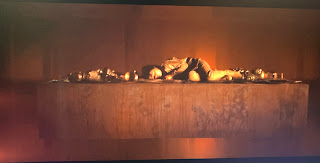Analyzing Technical Elements of Film
Hello!
My newest media studies assignment required me to analyze several varying technical elements of a film, of my liking. So, for this assignment, I've chosen the dystopian, thriller movie, "The Platform"! Since this movie's entirety takes place in the same setting and establishment, film producers had to get creative with distinct shots and plot elements to keep viewers engaged. "The Platform" is about a vertically-shaped prison where captives compete for food and face off against each other in the cruel reality of their eat-or-get-eaten world.
- "The Platform" (2019)
- Director: Galder Gaztelu-Urrutia
1. After the movie's opening scene, two characters including the movie's protagonist, "Goreng," can be seen talking. The older actor's character, "Trimagasi," explains how the vertical prison works. This provides information to not only the protagonist but also the viewers. These scenes of the characters are medium close-ups (MCU) and close-ups (CU) that were taken at an eye level. The type of shot size and angle add to the intense feeling of this scene. Combining these factors makes the conversation the characters are having and the dialogue being said, that much more significant. The director's choice to have the shots at an eye level provides a feeling of closeness and importance to the audience. Additionally, the scene later includes an overhead shot of Goreng that tilts downward as he peers down the gaping hole in the cell floor where other prisoners can be seen. Most notably, however, this shot is taken to further establish the concept of the prison's mechanisms that Trimagasi was explaining to Goreng earlier and to show how large the prison truly is. All these elements cause the viewers to feel intimidated.
2. Secondly, this next scene takes place after Trimagasi's death and is one of the movie's most unsettling moments because the protagonist is seen hallucinating and talking to him although he's dead and is eating the maggots off his body. Obviously, the context of this scene is already quite grotesque but is made more so by the choice of an extreme close-up (ECU) highlighting the maggots on Trimagasi's rotting body. This shot size forces the audience to focus on the disturbing details shown, effectively causing an uneasy and uncomfortable environment. The scene also includes an over-the-shoulder shot of Goreng's hallucination of Trimagasi as he watches him lay next to his body, which adds to the already intensely spine-chilling feeling of the scene. The next shot is overhead and at a high angle of the entire room, providing viewers a size comparison of the two bodies and the rest of the room. This makes viewers feel the solitude and isolation of the protagonist. Another factor worth mentioning is the red coloring placed over the entire area and the classical music being played as the scene unfolds. All these elements really drive home the director's attempt to not only frighten but show the audience the truly horrific reality of these characters as the music creates an uncomfortable comparison to what's being shown.
5. Lastly, the closing scene of the film is of a little girl on the platform of empty plates and glasses. What's significant about this scene is its size and movement. The filmmakers use a wide shot to show the young actress in relation to the platform and room. Additionally, the scene uses a tracking movement to show the platform rising rapidly in a continuous direction. This rapid movement and shot size help the audience feel closure for the film as it comes to an end.
Thank you! I had a lot of fun with this assignment.














Comments
Post a Comment